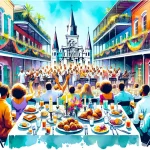New Orleans’ Mardi Gras Indians are a distinctive cultural tradition that blends African and Native American influences. These “tribes” of Black New Orleanians dedicate countless hours to meticulously crafting elaborate suits embellished with beads, feathers, and symbolic designs to wear during annual celebrations and parades.
In This Article
TL;DR
- The Mardi Gras Indians trace their roots to the shared oppression and cultural exchange between African Americans and Native Americans in New Orleans.
- Their intricately crafted “suits” showcase remarkable artistry and incorporate symbolic elements from both African and Native American cultures.
- The Mardi Gras Indians play a vital role in preserving and celebrating New Orleans’ rich cultural heritage.
Historical Background of Mardi Gras Indians
The origins of the Mardi Gras Indians date back to the mid-19th century when African Americans in New Orleans began masking as Native Americans during Mardi Gras festivities. This tradition is believed to have stemmed from the solidarity and intermingling between the two marginalized communities, as well as a desire to honor the Native Americans who provided refuge to escaped slaves.
Over the decades, the Mardi Gras Indian tradition evolved, with different tribes forming and developing their own unique identities, costumes, and rituals. The influence of African and Native American cultures is evident in the intricate beadwork, feathered headdresses, and symbolic designs that adorn the suits.
Significance of Costumes
The costumes, or “suits,” worn by the Mardi Gras Indians are true works of art, requiring thousands of hours of meticulous craftsmanship. The suit-making process involves intricate beadwork, embroidery, and the incorporation of various materials such as feathers, sequins, and even recycled objects.
Each suit is designed to tell a story, with symbolic elements representing different aspects of African and Native American cultures, as well as the tribe’s history and identity. The “Big Chief,” the leader of each tribe, wears the most elaborate suit, serving as a symbol of pride and respect.
Music and Chants of Mardi Gras Indians
Music and chants play a crucial role in Mardi Gras Indian gatherings and parades. Traditional songs and chants, often passed down through generations, are used to challenge and pay respect to other tribes. These rhythmic melodies, accompanied by percussion instruments like drums and tambourines, create a powerful and captivating atmosphere.
The influence of Mardi Gras Indian music can be heard in various genres of New Orleans music, including jazz and funk, further solidifying its cultural significance.
Mardi Gras Indian Tribes and Their Roles
New Orleans is home to numerous Mardi Gras Indian tribes, each with its own unique identity, territory, and familial ties. These tribes are more than just social groups; they are tight-knit communities that work together throughout the year to create their suits and preserve their traditions.
Key figures within each tribe, such as the Big Chief and Spy Boy, play vital roles during Mardi Gras. The Spy Boy scouts ahead to locate other tribes, while the Big Chief leads the tribe in chants and dances, showcasing their suits in a friendly yet competitive manner.
Annual Events and Parades
The Mardi Gras Indians’ annual events and parades are a highlight of the New Orleans cultural calendar. One of the most significant events is Super Sunday, typically held in March, where tribes gather to showcase their suits and engage in traditional chants and dances.
Another important event is St. Joseph’s Night, celebrated on the eve of St. Joseph’s Day, where the Mardi Gras Indians pay homage to their Catholic roots and the influence of Native American traditions. These events not only contribute to the local community’s cultural fabric but also attract tourists from around the world, eager to witness this unique tradition.
Cultural Impact and Preservation
The Mardi Gras Indians have had a profound impact on the art, culture, and education of New Orleans. Their intricate suits have inspired local artists, and their traditions have been incorporated into educational programs, ensuring that future generations can appreciate and understand this rich heritage.
Efforts are underway to preserve and protect the Mardi Gras Indian culture, including the establishment of organizations like the New Orleans Mardi Gras Indian Council, which works to promote and support the tribes.
Participation and Experience
While the Mardi Gras Indian events are open to the public, it is essential for locals and tourists alike to participate and observe with respect and cultural sensitivity. Guidelines for engagement and interaction with the tribes should be followed, such as maintaining a respectful distance and refraining from touching or interfering with the suits or rituals.
By following these best practices, visitors can experience this unique aspect of New Orleans culture in a responsible and meaningful way, gaining a deeper appreciation for the rich traditions and history of the Mardi Gras Indians.
Challenges and Future of Mardi Gras Indians
Like many cultural traditions, the Mardi Gras Indians face challenges in preserving their heritage. Factors such as gentrification, economic pressures, and the high cost of materials for suit-making can threaten the sustainability of this tradition.
However, efforts are underway to address these challenges and ensure the future of the Mardi Gras Indians in New Orleans. Community organizations, educational initiatives, and the dedication of the tribes themselves are working towards cultural adaptation and preservation, ensuring that this vibrant tradition continues to thrive for generations to come.






